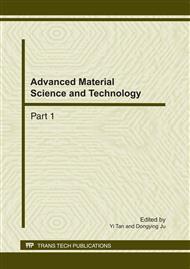p.383
p.387
p.391
p.395
p.399
p.403
p.407
p.411
p.415
Synthesis and Application of a Modifier to Enhance General Properties of the Polar Wood
Abstract:
A preparation method of modifier with low molecular weight and high reactivity is presented. This modifier (called KFK in lab)can impregnate into polar wood along trachea from the ends with pressurized impregnation method. In the following heating and pressing processes of the polar wood, the KFK polymerizes, and it enhances stability and strength of the wood. It showed that the favorable conditions for synthetic reaction of the KFK are: molar ratio of U and F, 1:1; reaction temperature, 20°C; reaction time, 3 hours; dosage of ignition primer A: 5%. Results from test showed the degree of crystallinity tested by XRD were 30%, 32% in different dosage of the modifier. Utilizing a combination of low molecular weight resin impregnation and pressing resulted in a density increase of KFK resin-treated wood from 0.214 to 0.268g/cm3. At the same time, the Young’s modulus and bending strength increased from 1.407GPa to 1.759GPa and 64MPa to 74.5MPa, respectively. It can be concluded that the effective utilization of KFK resin impregnated in polar wood is a promising technique for the production of high-strength in the drying and pressing processing.
Info:
Periodical:
Pages:
399-402
Citation:
Online since:
February 2011
Authors:
Keywords:
Price:
Сopyright:
© 2011 Trans Tech Publications Ltd. All Rights Reserved
Share:
Citation:


